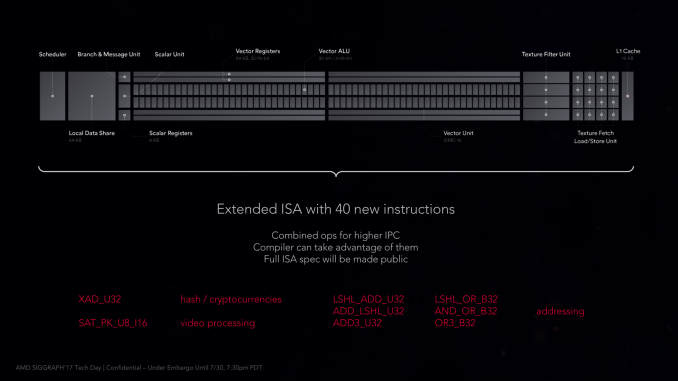The AMD Radeon RX Vega 64 & RX Vega 56 Review: Vega Burning Bright
by Ryan Smith & Nate Oh on August 14, 2017 9:00 AM ESTThe Vega Architecture: AMD’s Brightest Day
From an architectural standpoint, AMD’s engineers consider the Vega architecture to be their most sweeping architectural change in five years. And looking over everything that has been added to the architecture, it’s easy to see why. In terms of core graphics/compute features, Vega introduces more than any other iteration of GCN before it.
Speaking of GCN, before getting too deep here, it’s interesting to note that at least publicly, AMD is shying away from the Graphics Core Next name. GCN doesn’t appear anywhere in AMD’s whitepaper, while in programmers’ documents such as the shader ISA, the name is still present. But at least for the purposes of public discussion, rather than using the term GCN 5, AMD is consistently calling it the Vega architecture. Though make no mistake, this is still very much GCN, so AMD’s basic GPU execution model remains.
So what does Vega bring to the table? Back in January we got what has turned out to be a fairly extensive high-level overview of Vega’s main architectural improvements. In a nutshell, Vega is:
- Higher clocks
- Double rate FP16 math (Rapid Packed Math)
- HBM2
- New memory page management for the high-bandwidth cache controller
- Tiled rasterization (Draw Stream Binning Rasterizer)
- Increased ROP efficiency via L2 cache
- Improved geometry engine
- Primitive shading for even faster triangle culling
- Direct3D feature level 12_1 graphics features
- Improved display controllers
The interesting thing is that even with this significant number of changes, the Vega ISA is not a complete departure from the GCN4 ISA. AMD has added a number of new instructions – mostly for FP16 operations – along with some additional instructions that they expect to improve performance for video processing and some 8-bit integer operations, but nothing that radically upends Vega from earlier ISAs. So in terms of compute, Vega is still very comparable to Polaris and Fiji in terms of how data moves through the GPU.
Consequently, the burning question I think many will ask is if the effective compute IPC is significantly higher than Fiji, and the answer is no. AMD has actually taken significant pains to keep the throughput latency of a CU at 4 cycles (4 stages deep), however strictly speaking, existing code isn’t going to run any faster on Vega than earlier architectures. In order to wring the most out of Vega’s new CUs, you need to take advantage of the new compute features. Note that this doesn’t mean that compilers can’t take advantage of them on their own, but especially with the datatype matters, it’s important that code be designed for lower precision datatypes to begin with.











213 Comments
View All Comments
Lolimaster - Monday, August 14, 2017 - link
RXVega56 offwers a damn good value, smashing the 1070 for $100 less-Da W - Monday, August 14, 2017 - link
Think my Haswell + 780 rig is closing to retirement. A Vega 56 + Ryzen 1700X combo and a giant screen looks a good replacement.thartist - Monday, August 14, 2017 - link
The 1700X won't do any better for gaming if that's what you care about, but the card surely will.Lolimaster - Monday, August 14, 2017 - link
4c/8t extra to not care about cpu for a long time on top of being to actually do productivity things while gaming.Da W - Tuesday, August 15, 2017 - link
Actually i want a workhorse that can ALSO game fro time to time. What kids do to a life.......tipoo - Monday, August 14, 2017 - link
There's a cryptocurrency specific ISA addition, eh. People wanting it for graphics may hate it, but this may see huge demand from miners.extide - Monday, August 14, 2017 - link
Yeah, noticed that one too, heh.NeonFlak - Monday, August 14, 2017 - link
So, after reading this review I'm not sure what the point is of the Vega 64 for $100 more than the Vega 56.DanNeely - Monday, August 14, 2017 - link
The same thing as the 1080 over the 1070 in Nvidia land; which has a similar price/power/performance tradeoff. It's the fully enabled higher clock speed version for people willing to pay a premium for higher performance and who're less concerned about power/dollar efficiency.Jumangi - Monday, August 14, 2017 - link
Not with its performance and terrible power/heat it does. The Vega 56 is a solid competitor to the 1070 but the 64 does very poorly against the 1080.